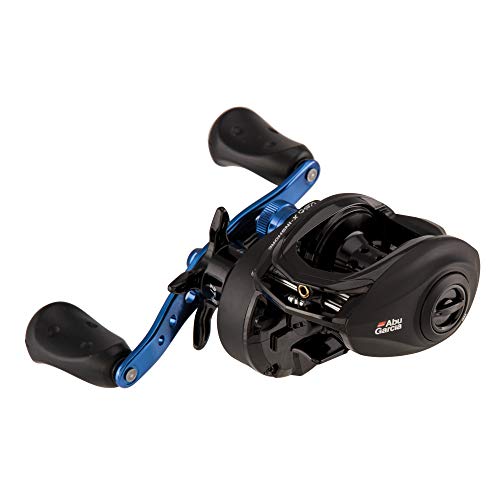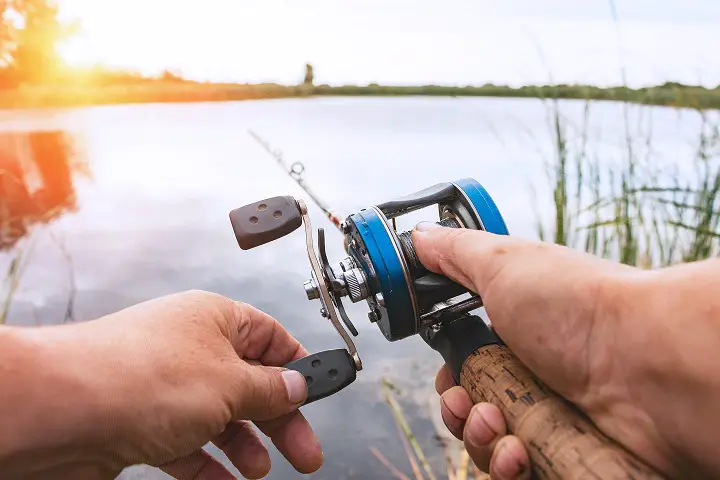
Fishing is an activity that should be fun for enthusiasts of any age or gender. With the right tools and equipment, fishing can even become more fun. In the past, people only used a simple line in a hook. Now, fishing tools and accessories have become more and more sophisticated. It did not only make fishing more fun, but it also made it easier.
Though some people would say that these tools took out the challenge from the said outdoor activity, many would debunk this, however, by arguing that these tools do not replace one’s skill in catching fish. Instead, it makes them become more strategic and competitive in catching fish.
When it’s your first time fishing using any of the new fishing equipment, the first thing that you should decide on is whether or not you will be using a baitcasting reel. Aside from this reel, you can also use a spinning reel. These two are the most common reels that can serve every fisherman’s needs.
Top 5 Best Baitcasting Reels for Saltwater (Summary)
For more detailed and complete product reviews on benefits and features, keep reading.
While the latter kind of reel is great for novice learners, it can’t keep up with you as your skills evolve. When you have significantly improved your fishing skill set, that’s where baitcasting comes in.
No one starts fishing and remains at the same level after some practice. Regardless of how slow your progress is, at some point, you will eventually level up with your tools to add challenge and a certain level of difficulty to the task. If you want to also improve the output of your fishing trip, then consider purchasing a baitcasting reel. While you acquire more skills, you should acquire more information to make an informed choice when buying your fishing equipment.
Baitcasters, also more formally known as baitcasting reels, are fishing tools for fishing enthusiasts who want to achieve more precision and control in using their casts. This tool is ideal for those who already have previous experience perfecting and improving their fishing techniques.
In this guide, we will lay down all the necessary and crucial facts you need to know about baitcasting and its components. At the end of the day, the main goal of this guide is to help you weigh all the facts and come up with a clever and enlightened choice.
9 Best Baitcasting Reels for Saltwater Reviews
1. KastKing Spartacus
KastKing Spartacus Baitcasting Reel combines high-quality and innovative features to provide powerful performance consistently. It is available in left-handed and right-handed models and allows you to enjoy the powerful features on freshwater or saltwater.
It features a unique micro-cast dual centrifugal and magnetic brake system. With a carbon fiber drag of up to 17.5 pounds and instant stop anti-reverse, the reel is capable of catching and stopping large fish.
The reel has a strong graphite body and side covers that can be quickly removed. It has shielded ball bearings made of stainless steel and powerful precision matched brass gears.
CNC machined aluminum spool allows you to cast smoothly and precisely at all times. It has durable cork handle knobs made of rubber. All components are corrosion resistant and long-lasting.
Pros
- Allows for precise and smooth casting at all times
- Features are corrosion resistant
- Capable of catching large game
Cons
- Brakes might become defective after some time
2. Piscifun Torrent
Piscifun Torrent Baitcasting Reel is a premium product that features precision-cut gears, screws and springs made of stainless steel that provide optimum strength. With this reel, you are guaranteed a reliable operation and powerful water resistance.
It is outfitted with four custom carbon fiber drag washers that can be fine-tuned easily. The carbon fiber has a powerful 18 pounds drag that allows you to handle fishes of all sizes.
Its bearings are properly shielded and protected from damage by water, oil and other substances. It has an aluminum spool with five magnets that help to optimize the magnetic effect of the spool. It also features a precise dial-in-gauge that helps to control backlash.
A unique oil port located on the side plate allows you to carry out maintenance of the reel easily. It has double line winding shafts that provide stability and strength.
Pros
- Has an 18-pound carbon fiber drag
- Bearings are protected from damage and wear
- Easy to maintain
Cons
- Might make a loud, screeching noise when it is casted
3. KastKing MegaJaws
KastKing MegaJaws is a fully optimized product that is powerful enough to be used for regular fishing or fishing tournaments. It will continue to provide excellent operation on freshwater and saltwater for a long time.
A color-coded gear ratio system allows anglers to easily and quickly identify specific gear ratio reels for different fishing conditions. It has double-shielded stainless steel ball bearings.
Its main and pinion gears are made of brass and they provide extra strength and durability. It is outfitted with a worm gear made of nickel coated brass that ensures optimal performance.
With its powerful carbon fiber drag washers, the reel eliminates inconsistent drag tension. The drag washers deliver a drag power of up to 17.6 pounds for optimum fish stopping power in the toughest of conditions.
Pros
- Features a color-coded gear ratio system
- High-quality gears
- Powerful drag washers that prevent inconsistent drag tension
Cons
- Cork handles might get stiff or break off during use
4. Cadence CB5
Cadence CB5 Baitcasting Reel comes in a variety of gear ratios and is suitable for the majority of baitcasting techniques and conditions. At just 7.5 ounces, it is a lightweight product and helps to reduce fatigue while casting for a more enjoyable fishing experience.
A magnetic brake system and tension knob can be adjusted externally. These features eliminate backlash and are easy to adjust. A carbon fiber drag system can deliver up to 20 pounds of drag.
It is outfitted with a super low torque BB system that provides super-fast line speed and an increase of up to 30% in the casting distance. It also provides optimum smoothness and offers minimal resistance.
The spool and handles are made of aviation class aluminum and they are resistant to corrosion. It has a 6:6 gear ratio that provides faster retrieves and helps you to fish efficiently.
Pros
- High-performance brake system that can be easily adjusted
- Long casting distance
- Drag system provides up to 20 pounds of drag
Cons
- Might provide less drag after some time
5. Shimano SLX
Shimano SLX Reel packs a few game-changing features with a clean-cut and sleek finish. The product comes in a range of gear ratios, making it ideal for various fishing techniques.
It features a Variable Brake Adjustment system that helps to eliminate backlash adequately. The brake system uses centrifugal force instead of magnets, to better control the cast.
It has a 4-bearing system with one reverse bearing for smooth casting. It also features a drag system that provides up to 12 pounds of drag.
The unique Hagane body technology makes the reel stiff and resistant to flexing or warping due to high impact. The reel is compact and rigid with a long handle.
Pros
- Unique brake system that provides better control of the cast
- Drag system provides 12 pounds of drag
- Body can withstand heavy weight without getting warped
Cons
- Handle might be stiff and difficult to operate
6. Okuma Classic CLX
Okuma Classic CLX Reel is a right-handed product that offers high-grade operation in all types of fishing conditions. It contains high-quality features that help to reduce the stress of fishing.
A star drag mechanism allows you to catch and pull fish of great sizes. The reel is an ideal product for both amateur and professional anglers as it can serve optimally in tough conditions.
With a weight of 8 ounces, it is a lightweight product that eliminates strain and allows you to keep fishing for a long time. It features side plates that are coated to prevent corrosion.
A ported graphite frame design is strong and durable. It also has a graphite spool that is corrosion resistant.
Pros
- Has a star drag system for optimal fish stopping power
- Lightweight
- Side plates and spool are corrosion resistant
Cons
- Might not be able to cast at a long distance
7. Nordtale Aztec
Nordtale Aztec Baitcasting Reel for Saltwater is a low profile product that is also ideal for freshwater and ice and trout fishing, among others. With its extra smooth performance, the reel is a suitable option to use, whether during leisure or for a competition.
A 7:0:1 gear ratio provides a super silent high speed. It has a 10 level dual magnetic and centrifugal brake system that is easy to adjust and provides optimum casting control.
It features corrosion-resistant ball bearings and a line guide that is compatible with braided and monofilament fishing lines and a lightweight spool made of anodized aluminum.
It has three advanced carbon fiber drag washers and an extended extra-drag handle. There are also non-slip EVA grip knobs for better grip and comfort.
Pros
- Brake system provides high-quality casting control
- Has corrosion resistant ball bearings
- Non-slip EVA grip knobs
Cons
- A small amount of impact might cause the reel to lock up
8. Abu Garci
Abu Garcia Reel is a high-performance product that takes the strain out of the fishing experience. It is a low profile casting reel that can be used in freshwater and saltwater environments without getting damaged.
Six stainless steel ball bearings with one roller bearing provide a smooth and effortless cast. It features 3 HPCR bearings in specific locations that further aid the casting ability of the reel.
The frame is made of a high-grade alloy that is durable and can withstand heavy weight without getting bent. It can be used for all kinds of fishing techniques without sustaining damage.
It can provide up to 30 pounds of drag, allowing you to catch the big fish without stress. It is most suitable for a braided fishing line.
Pros
- Provides a smooth and effortless cast
- Durable alloy frame
- Gives up to 30 pounds of drag
Cons
- Features might not be resistant to corrosion
9. Sougayilang Rover
Sougayilang Rover Baitcasting Reel is a powerful tool that can change your fishing routine for good. It features brass and steel components that provide premium corrosion power, making it suitable for use in saltwater environments.
With the high-performance anti-rust treatment on the outer casing, the reel can stand up to fishing at the seaside. It has three stainless steel bearings and one roller bearing for extra smoothness.
A powerful drag system provides smooth and consistent drag. It has long-range casting performance and anti-friction property. It uses a centrifugal brake system to apply consistent pressure for a precise cast.
Extended bent cranking handles and power knob offers added strength for pulling fish. It has an aluminum alloy rotating disc that helps to improve the gear rotation resistance.
Pros
- Optimized for saltwater fishing
- Powerful drag system
- Centrifugal brake system provides precise cast
Cons
- Might be a bit heavy
What Are Baitcasting Reels for Saltwater
If you are still not quite familiar with baitcasting reels specifically used for saltwater, then you’re likely to find the information you need here. But before we discuss saltwater baitcasting reels, it’s more fitting to lay the foundation by discussing what are baitcasting reels in general.
As mentioned above, a baitcasting reel is a fishing tool ideal for fishing enthusiasts who want to improve their skills. Aside from that, the baitcasting reel is the tool that fishermen usually place on top of their casting rod. The purpose of such a tool is to lure fish effectively towards the fisherman. If you want to catch more fish using this tool, you have to learn how to control it first.
This reel is specifically aimed at reaching that control level that shows maximum fishing results. If the angler doesn’t want to use a baitcasting reel, he can opt for a spin casting reel. Then again, this won’t give him the same level of efficiency and control a baitcasting reel can give.
To make a great catch, the angler needs certain stability to lure his catch and pull them out of the deep effectively. This is where a baitcasting reel becomes valuable as this tool serves as the support system giving the necessary stability. It is the baitcasting reel’s strength that supports anglers.
Baitcasting reels are also best for heavy fishing lines with its spools perpendicular to the reel’s fishing rod. So, if you want to fish with heavier fishing lines, a baitcasting reel is your best bet. It can make your angling more productive.
Baitcasting reels for saltwater are basically reels that are corrosion-resistant since it is used for fishing in saltwater. Just like any saltwater gear, your baitcasting reel needs to be made from materials that can be used in and around the ocean. As you already know, oxygen, moisture, and salt can have a lethal effect on the metal. As such, it is extremely crucial that the fishing rod is made with corrosion-resistant materials.
Benefits of Using Baitcasting Reels for Saltwater
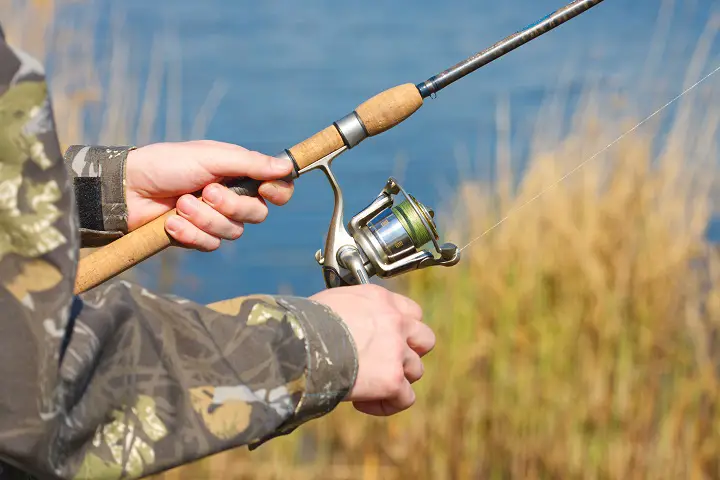
There are countless of benefits an angler can take away from using a saltwater baitcasting reel and these benefits include the following:
Designed for Casting
Compared to conventional reels, baitcasting reels are better for casting. Baitcasting reels are also more popular among inshore saltwater and freshwater anglers. It usually includes braking systems that aim to reduce incidences of backlash. It also includes a level-wind mechanism that facilitates the back and forth movement of the line when it is reeled in. Because of this, there is no need for anglers to guide the fishing line using his thumb.
Higher Line Speeds and Gear Ratios
Compared to spinning reels, the line speeds and gear ratios of baitcasting reels are higher, effectively helping anglers to give buzz baits, crankbaits, and other special lures they can execute to lure in more fish. If you’re using a spinning reel, the space that allows you to pull a buzzbait can be exhausting. This is why baitcasting is more preferred.
More Accurate Casts
In baitcasting reels, the reel is perpendicularly mounted on top and to the fishing rod, eliminating the need for a stationary pool. With this, the fishing line comes out in a straight line that’s close to the rod, allowing for better and more accurate casts than spinning reels.
Corrosion-Resistant
Oxygen, moisture, and salt can have a lethal effect on the metal. As such, it is extremely crucial that the fishing rod is made with corrosion-resistant materials. Given this, make sure to get a fly reel that’s resistant to corrosion.
How do Baitcasting Reels for Saltwater Work
Most anglers are accustomed to plying their craft in largely similar ways. However, there are a couple of significant differences between fishing in saltwater and in freshwater.
For one, saltwater anglers usually fish deeper using more robust gears compared to their freshwater counterparts. Aside from employing more complex gears, they also need to employ different techniques, strategies and tackle to lure in and catch fish. The main difference between these two main reel types is the water wherein they are used.
Saltwater baitcasting reels are made specifically to withstand the harsh and salty conditions in the sea. They work just like the ordinary reel, except that they are more resistant to rust that might be caused by saltwater.
Pros and Cons of Baitcasting Reels for Saltwater
To help you weigh whether or not baitcasting reels for saltwater is for you, here are some of the pros and cons of the said fishing tool.
Pros
- Better control and highly efficient
- Tailored to meet individual needs
- Will make your fishing business more productive
- Less line twist
- Easier to slow bait
- Improved accuracy with heavy lures
- A larger variety of available gear ratios
- Lighter reel weight
- The best option for heavier lures and lines
- Greater line capacity
- More durable than spinning reels
Cons
- Baitcasting reel could be difficult for a novice angler to use
- They are heavy
- They can be handled most effectively by experienced anglers
- Takes time to learn and use
- Can wear out lighter lines
- Harder maintenance
- Relatively expensive
- Complicated without experience
- Bird nesting and jamming more common
- Lines can dig into the pole during flexing
Types of Baitcasting Reels
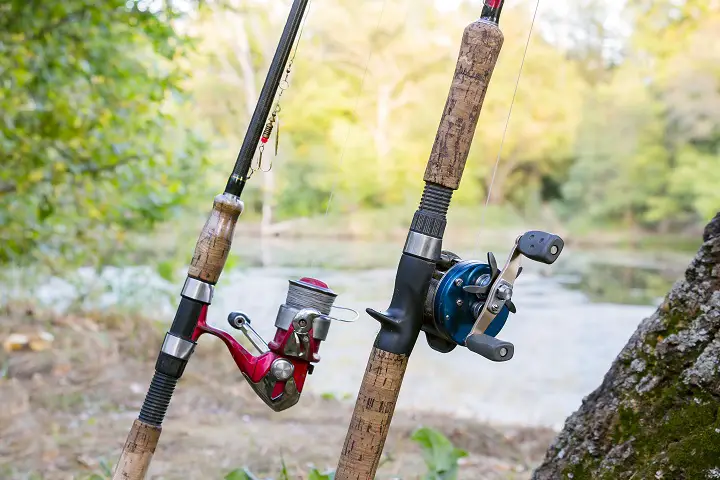
Before you purchase your first ever baitcasting reel, you have to know first what options do you have. Baitcasting reels come in two different types – round profile reels and low profile reels.
Both reels are designed differently and made for different fishing styles. The angler’s preferred line capacity will help determine which among these two types of baitcasting reels are more suitable.
Round Profile Baitcasting Reels
The main distinguishing factor of round profile baitcasting reels is its grip that’s pulled from behind. With such a grip position, greater torque is produced compared to low-profile versions.
Aside from this, another distinguishing factor is the amount of line the reel can hold. Compared to its contemporary, round profile reels can hold more line. This is the reason why this kind of reel is adapted by anglers who prefer to fish in greater depths.
If you are planning to fish for salmon, steelhead, and spike, your best bet is a round profile reel. It is also worthy to note that most round profile reels are typically made of metals that are most suitable for saltwater angling.
Low-Profile Baitcasting Reels
This kind of reel is adapted by anglers that are looking for reels that are easy to use. The ergonomic design of this kind of reel makes it easy on the angler’s wrist. Anglers can also hold this kind of reel easily. The design and mechanism of this reel allow better stability and is most suitable for anglers that want a more comfortable reel. If you want to fish for bass, then this type of reel is best for you. Remember that a bass fishing rod can work with a heavier bait.
Also, if you are aiming for more casting instead of fishing for the bigger fish, this kind of reel is best for you. The comfort and ease of using this kind of reel are attributable to their lightweight build and nature. The material used to make this kind of reel is graphite. There are also other more lightweight reels that are made of carbon composite.
How to Choose the Best Baitcasting Reels for Saltwater
Now that you know the two main types of saltwater baitcasting reels, let’s now proceed to knowing the several factors that any angler should understand when choosing their reels. These factors will indicate the efficiency of the reel.
Bearings
The main role of reel bearings is to reduce the friction between moving gears. Apart from this, the bearing is also responsible for improving the lifespan of the product. If you use more bearing, expect that you will also get better cast. Then again, take note that the quality of the bearings also matters. A reel with five high-quality bearings, without an iota of doubt, performs way better than a reel with ten poor-quality bearings.
When it comes to performance, bearings are rated from 9 to 1, with 9 as the highest and 1 as the lowest. In baitcasting reels, the bearing determines the reel efficiency. It also determines the smoothness and retrieval capacity of the casting. It does not matter what type of bearing you are using, the most efficient is the one made from high-quality steel or ceramic.
If you are shopping for ball bearings, the most important thing that you should look for is the quality of the material. The number of ball bearings will never guarantee its quality. Look for ball bearings that have a complete sealing feature since this can prevent seawater from entering. It’s also a basic rule to look for bearings that are made from high-quality materials.
Profile
As discussed in the preceding paragraphs, there are two profiles when it comes to baitcasting reels — low and round profiles. The round ones usually have larger line capacity for bigger fish to take when it’s going for the run. Low-profile reels, on the other hand, allow its angler to use their index finger to rest his line after palming the reel. This paves the way for more sensitive feedback in detecting strikes coming from the line.
Drag Systems
The fishing reel’s drag system is made up of a group metal drag washers and adjustment points that are usually separated by felt washers or carbon fiber to lessen friction. The drag system is responsible for moderating the force that is applied on the line prior to the spool slipping out.
As a general rule, the drag must be set at 20 to 30% of the line’s breaking strength to keep the same line from breaking while fishing. For instance, you are using a 15-pound test, your drag should be set within three to four point five pounds. To check your drag’s settings, use a hand-held spring scale. And since the vast majority of the baitcasting reels are using a star drag system, make sure that before casting, you set your drag properly. This can lessen the awkwardness of fishing and will also keep you from losing your catch due to too little or too much drag.
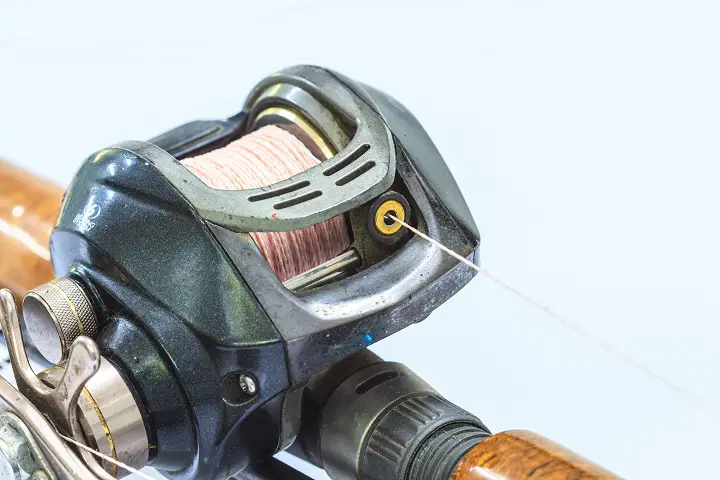
Line Capacity
In looking for a baitcasting reel to buy, you should also consider the line casting as this can affect your ability to make longer runs. It’s the angler’s fishing style that will determine the most appropriate reel line capacity.
Braking Systems
There is no catch or plot twist here. Just like how normal brakes function, the braking system in the baitcasting reels function as the control center for your reel’s spool. It keeps certain occurrences like birds’ nests from frustrating the angler.
The mechanical brakes, more popularly known as the centrifugal brakes, function like car brakes. It has a pin responsible for disengaging and engaging the reel. This kind of reel brake is more common in traditional reels. They function by avoiding backlash.
Magnetic brakes, on the other hand, were specifically designed as the braking system’s modern modifications. They come with a handle that can be aimed and maneuvered easily. Then again, according to a number of fishermen, this type of break is not very good at preventing a backlash.
In more expensive baitcasting reel models, you’ll see magnetic breaks. These breaks are of the mechanical kind. And though these are used often in pricier models, these are the easiest and cheapest braking system to learn. It is also the least efficient when dealing with adjustments.
Gear Ratio
The reel’s gear ratio determines its speed, this is why you also need to consider this aspect when choosing which reel is the most suitable for you. When you compare gear ratios, go for those with low handle turns value and high revolution number. The common gear ratios of the most efficient reels are 7:1:1, 6:4:1, and 5:3:1. If you will be aiming for tasking fishing techniques, the one with higher gear ratios is the most suitable reel for you.
Gear ratios dictate if the real is fast, moderate, or slow. Faster reels are somewhere within 7:1:1 and 7:2:1. Moderate-speed reels, on the other hand, are somewhere between 6.0.1 to 6.4:1. Lastly, slower-speed reels have a speed of 5:9:1. Reels with a very high gear ratio include those up to 8:1:1.
Corrosion Resistance
Baitcasting reels for saltwater are usually made of different kinds of simple metals. These metals work fine even in a saltwater environment. Unlike freshwater reels that corrode even in freshwater environments, saltwater reels can withstand harsh saltwater conditions.
Since saltwater can easily corrode any metals in a short time, most rods for saltwater are made from alloys that will not succumb easily to corrosion. In some other cases, there are saltwater reels that are made with materials that can be corroded, but a protective coating is applied on its surface to help them bear up against frequent saltwater contact.
Spool Size
The reels’ spool size will help determine whether or not such reel is suitable for your needs. If you are fishing for heavy lines, you must go for bigger spool sizes. These sizes are easier to regulate and control.
Reel Handle Position
Traditionally, reels have their handle on the right side. This means that a caster who is dominantly right-handed will make a cast then switch the rod to his left hand so that the reel can be cranked using his right hand. Though this may sound cumbersome, seasoned bait casters are aware that this becomes quicker and simpler with more practice.
Today, there is a growing number of modern reels that can pass up as the left-handed versions of these right-handed ones. This newer version has the reel handle placed on the left side. With this reel handle position, a caster who is right-handed casts using his right hand then reels using his left.
While this is not what most traditional anglers are accustomed to, in practice, it makes more sense. With left-handed reel, you don’t have to switch hands after casting. As such, you will never lose contact with your lure. And if a fish hits when the lure lands, you won’t have to wait for the hook setting.
Reel Weight
Since angling is largely dependent on the reel, the reel’s weight must also be seriously considered. The said weight is especially crucial for anglers who angle for long periods. The reel weight is also dependent on one’s fishing style.
Low profile reels are more known to be lightweight Being such, they are best for freshwater and inshore angling. In saltwater angling, the best reel profile is the round one since they are typically heavier.
Retrieve Rate
Every baitcasting reel comes with a specific gear ratio. The gear ratio translates to the number of times the spool turns compared to the number of times the handle is cranked. Each gear ratio is suitable for a specific fishing style.
As mentioned above, gear ratios dictate if the real is fast, moderate, or slow. Faster reels are somewhere within 7:1:1 and 7:2:1. Moderate-speed reels, on the other hand, are somewhere between 6.0.1 to 6.4:1. Lastly, slower-speed reels have a speed of 5:9:1. Reels with a very high gear ratio include those up to 8:1:1.
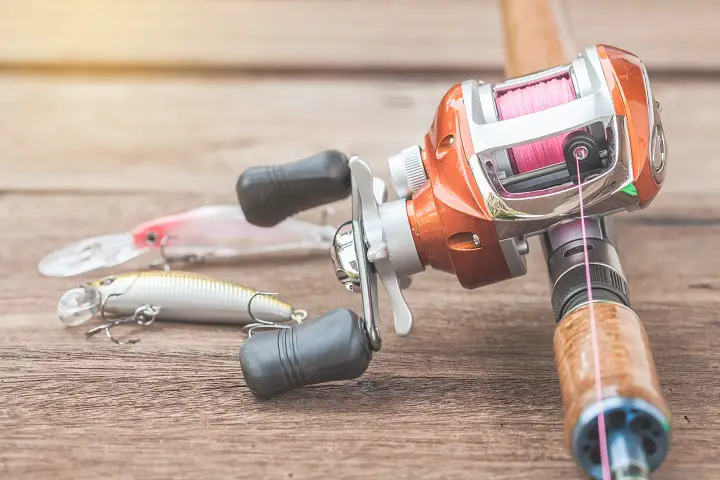
Frame Materials
In terms of frame, baitcasting reels usually have frames made from graphite, alloy, or aluminum. The most expensive and the best performing among these frames are those made from aluminum. The more common but less strong ones are made from graphite or alloy. The reel’s frame serves as its foundation, that’s why you have to make sure that this one is sturdy.
Baitcasting Reel vs Spinning Reel
As mentioned in the first few paragraphs of this guide, reels can either be a spinning reel or a baitcasting reel. Since we already know that spinning reels are lightweight, easy to use, and are more preferred for anglers who are still practicing and mastering fishing techniques, let’s now discuss, in detail, how it compares to a baitcasting reel.
What will eventually determine the right reel for you is your fishing plan. Here are some important points to consider when you are still in limbo as to which reel to purchase.
Type of Fish You Want to Catch
The first consideration that can help you decide which among these two reels you should buy is the fish that you want to catch. It is important to note at this point that all fishing gears you intend to use should be fitting to the fish species you want to catch.
As a general rule, spinning reels are ideal for average-sized fish. You can also use it to catch all species below the medium-size category using a spinning reel. However, if you want to tackle fish of the larger and heavier species, a baitcaster is the right choice.
Lure and Line
Next to the size of the fish you want to catch, you should also consider the line you want to use. Remember that a combo of fishing rod and reel is great for professional anglers.
If you’ll be using lines that are around ten pounds, a spinning reel is a logical choice. This reel will give you the bendiness and flexibility you need without breaking the line. On the other hand, if you intend to use heavier lures and lines, a baitcaster can provide you with a better and high-level control.
Reels for Beginners
While the spinning reel is great for novice learners, it can’t keep up with you as your skills evolve. Even the world’s best spinning reel reviews highlight the skill limitations of the spinning reel. When you have significantly improved your fishing skill set, that’s where baitcasting comes in.
No one starts fishing and remains at the same level after some practice. Regardless of how slow your progress is, at some point, you will eventually level up with your tools to add challenge and a certain level of difficulty to the task. If you want to also improve the output of your fishing trip, then consider purchasing a baitcasting reel. While you acquire more skills, you should acquire more information to make an informed choice when buying your fishing equipment.
If you want to stick with a spinning reel, however, just make sure to spin-cast reel with great performance and ease of use.
Accuracy
When it comes to accuracy, spinning reels cannot give the level of accuracy and control seasoned anglers need. This will serve the beginners well, but the skilled ones will always prefer the baitcaster reel. Because of its high-level casting accuracy, baitcasting reels allow you to aim for a specific spot and hit it accurately every single time. In case of a bad cast, all you have to do is stop the baitcaster quickly to avoid bigger problems.
Maintenance
Reel maintenance is crucial in maximizing the durability of every fishing equipment. Fortunately, for reels, not much work is required to keep it in sterling condition. All you have to do is disassemble the reel and clean its components with the right cleaning solution. Remember to oil the bearing and grease the teeth of the reel. Once done, you can immediately reassemble everything.
Compared to the two reels, the structure of the baitcaster reel is more complex. This explains why cleaning it takes more time. Then again, longer cleaning time does not always mean more difficult.
Affordability
The price is largely dependent on the unit. Then again, as a general rule, spinning rules are cheaper. If you are looking for something that will last for a long time, the baitcaster is the right one for you.
Durability
If you want a reel that’s in it for the long haul, go for a baitcasting reel. This reel is complex in structure, making them more durable and sturdier compared to their counterparts. Then again, you must also remember that maintenance plays a huge role in durability, as well as the events that might pop up during the fishing trip. Yes, baitcasting reels are capable of handling larger fish species, but it does not mean that they are unbreakable.
Tangling and Jamming
Nothing more can frustrate an angler than a frequent tangling or jamming of his reel. While these incidences may really happen at some point, you can minimize its occurrence by choosing a reel that is less susceptible to such events.
The truth of the matter is, there is no guarantee that your lines will not break or tangle. Then again, when you’re looking for a reel that’s less susceptible to jamming, spinning reels are better.
Left Handed vs Right-Handed Baitcasters
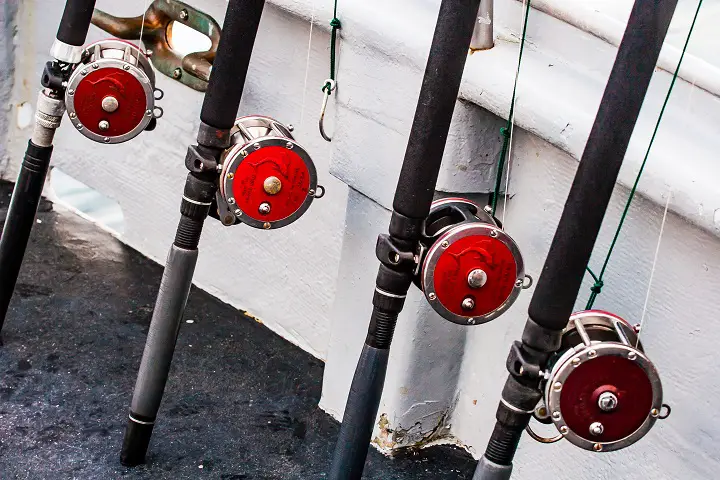
Traditionally, reels have their handle on the right side. This means that a caster who is dominantly right-handed will make a cast then switch the rod to his left hand so that the reel can be cranked using his right hand. Today, there is a growing number of modern reels that can pass up as the left-handed versions of these right-handed ones. This newer version has the reel handle placed on the left side. With this reel handle position, a caster who is right-handed casts using his right hand then reels using his left.
People usually have a more dominant arm. You use your dominant arm to write, shoot, throw, and perform tasks. The same principle applies to fishing. Your dominant arm will learn to cast the rod more easily compared to your offhand. In the end, it will also perform better with casting accuracy, fluidity, and efficiency. The offhand is not left for turning the crank handle of the reel.
How to Use Baitcasting Reels for Saltwater
To help you understand how to use your newly-purchased baitcasting reel better, here is a step by step guide you can follow.
Step 1 – Reel the line inward
Do this until your lure about six to 12 inches from the tip of your rod. If a bobber or sinker is attached to your line, remember to keep it about six to 12 inches from the tip of your rod.
Step 2 – Hold your reel properly
Rest your thumb over the spool and grip the fishing rod behind the reel. Cast the reel using the same hand for retrieving it. However, if you are more comfortable in holding the rod behind the reel when retrieving it, switch hands as you cast. You can also rest your thumb on the spool at a slight angle instead of pressing the spool flat on the line. This allows more control over the line flow while casting.
Step 3 – Turn your rod in a way where the reel handle points up
If you are casting using your opposite hand, make sure to point the handles down.
Step 4 – Press the release button of the spool
Older baitcasting reel models have a reel spool disengaging mechanism from its handle. This prevents the reel from turning while casting. It also allows longer casts. The newer models, on the other hand, sport a release bar found on the back the spool, right at the spot where you press your with your thumb when resting it on the reel spool.
Step 5 – Bend your casting arm
While doing this, you need to raise your fishing rod until the tip slightly goes past vertical. This position will support the sending of the line out.
Step 6 – Sweep your rod in a forward position until it’s within eye level
The said level is above horizontal by 30 degrees or in a 10 o’clock position. While doing this, also lift your thumb slowly off the spool to make the lure weight pull the line off your spool while it propels toward your target. If you’re using a long-handled rod when you cast, you may want to use your other hand to serve as a fulcrum that will help pivot your rod when you cast.
Step 7 – Press the reel spool down and wait for the bait to reach your target
This is like pressing the spin casting reel button to put a brake on the line.
How to Maintain Baitcasting Reels for Saltwater
As already highlighted in the previous paragraphs, keeping your baitcasting reels clean and well-maintained significantly impacts its lifespan. So, to help you make your reels remain in good operating condition, here is a step-by-step guide on how to clean your baitcasting reel.
Step 1 – Ready your cleaning supplies
Prepare the following cleaning tools — Q-tip, rubbing alcohol, and a clean towel.
Step 2 – Get a clean towel and wet it with fresh water
Use this wet towel to get rid of any impurities and dirt on the external surface of your baitcasting reel. Also, make sure to carefully wipe off the grime and salt that may have built up over the day.
Step 3 – Clean the inside parts
Remove the reel spool first by popping the side plate open. If your spool has a lone, it is best to tap around the line to make sure it’s not hanging off. Also, make sure that tags are not spilled in between the spool and frame when you put them back together.
Step 4 – Clean the flange area
After removing the spool, it’s time to get your Q-tip and apply a decent amount of rubbing alcohol on it. Using the Q-tip, reach for the flange areas inside the reel frame. If you’re not familiar with the flange area, this is where the spool’s flanges ride. When cleaning this area, you have to go for the side handle and side plate.
Step 5 – Move to the pinion gear
Remove a bit of cotton from the Q-tip’s end and make sure it’s thin enough to be inserted in the pinion gear. Pour a small amount of alcohol on the cotton and insert the same to the pinion gear. To remove excess salt, dirt, and oil, use the Q-tip and clean the area in a back and forth motion.
Step 6 – Use a towel to wipe the spool’s main shaft down, as well as its flanges
Once you’re done cleaning, you can put the spool back and also attach the side plates back into its rightful place.
Does More Spending Mean More Quality
When it comes to reels, a more expensive reel like the baitcaster is said to be more durable and sturdy compared to its cheaper contemporaries. The reason behind the more expensive price tag is the quality of the materials being used to make the product.
More expensive reels mean a stronger aluminum frame, a better gear ratio, a line that’s less susceptible to breaking, and so on. Then again, if you don’t maintain and take care of your reels, the purpose of buying an expensive one for its premium quality becomes moot and academic becomes a lost cause.
Do’s and Don’ts With Baitcasting Reels for Saltwater
To better take care of your saltwater baitcasting reels, here are some do’s and don’ts that you should observe.
Do’s
- Buy only the premium baitcasting reel.
- Know what kind of fish species you would like to catch before investing in a reel.
- Determine your fishing goal when choosing between a spinning reel and a baitcasting reel.
- Make sure to improve strength and flexibility with a surf fishing rod.
- Clean your fishing gear after every fishing expedition.
- Check every aspect of the reel before buying.
- Invest in a set of pliers for fishing.
- Decide only after you have exhausted all the information about the reel that you intend to buy.
- Identify which is your dominant hand and use it as a reference when choosing between a left-handed or right-handed reel handle.
- Go for a fly rod with longer casting.
- Use a long and durable catfish rod.
Don’ts
- Buy reels only for the brand or price.
- Leave your baitcasting reel unclean after a saltwater fishing expedition.
- Use reels with a lower gear ratio for fishing bigger fish species.
- Leave your reels exposed to harsh weather conditions.
FAQ About Baitcasting Reels for Saltwater
Here are the answers to the most commonly asked questions about baitcasting reels for saltwater:
Is Shimano Curado a saltwater reel?
Most people consider Shimano Curado is a freshwater reel, but according to its manufacturer, it is also perfect for inshore saltwater fishing. The only precaution you should know is that it’s not designed to be sealed. This means you need to make sure that you rinse it properly after every saltwater fishing expedition.
What’s better, spinning reel or baitcaster?
When it’s your first time fishing using any of the new fishing equipment, the first thing that you should decide on is whether or not you will be using a baitcasting reel. Aside from this reel, you can also use a spinning reel. These two are the most common reels that can serve every fisherman’s needs. While the latter kind of reel is great for novice learners, it can’t keep up with you as your skills evolve. When you have significantly improved your fishing skill set, that’s where baitcasting comes in. If you want to also improve the output of your fishing trip, then consider purchasing a baitcasting reel.
How do you spool a baitcaster?
You need these materials to add a line to your reel – pencil, monofilament fishing line, reel, and rod. You also need the help of a fellow angler to execute this successfully.
The first thing you should do is to attach the reel to the fishing rod. Next, feed the line to the rod’s first eyelet. Once the fishing line is already in, attach it to the spool of the reel. Wrap the line on the spool and using an overhand knot, tie the spool around the main fishing line. Finish the knot by tugging and pulling the mainline until the knots tighten on the spool. You call this an arbor knot.
Once you have trimmed the tag end, spool the reel immediately. Ask your friend to place some tension on the line and start reeling and filling up the spool.
To avoid future casting issues and line twisting, make sure to allow your fishing line to come off the spool, just like how the baitcaster reel went in. Spool continuously until the reel is full of lines. Trim the spooled line from the thread that went through the rod eyelets.
How do you prevent backlash on a baitcaster?
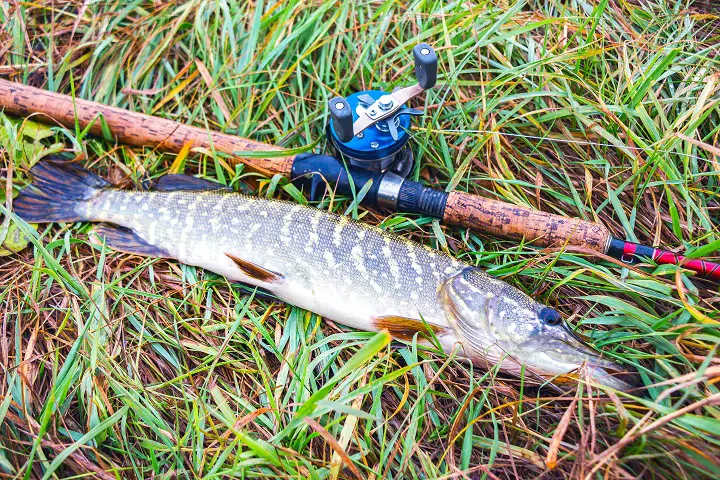
Baitcasting reels usually include braking systems that aim to reduce incidences of backlash. The mechanical brakes, more popularly known as the centrifugal brakes, function like car brakes. It has a pin responsible for disengaging and engaging the reel. This kind of reel brake is more common in traditional reels. They function by avoiding backlash.
Magnetic brakes, on the other hand, were specifically designed as the braking system’s modern modifications. They come with a handle that can be aimed and maneuvered easily. Then again, according to a number of fishermen, this type of break is not very good at preventing a backlash.
Can I use a spinning rod with a baitcaster?
Technically, you can. However, this is not recommended because the spinning rod usually uses a spinning reel. Since the spinning reel is the exact opposite of a baitcasting reel, they are not specifically designed to work together.
Can you trout fish with a baitcaster?
Even if you only work with a baitcaster, you can still catch as many trout as you can. However, you need to use a light lure and the right techniques to make it work. To cat light lures using a baitcaster, you need to let your rod power the cast.
Is mono or braid better for baitcasters?
Technically, baitcasters can be spooled using any kind of fishing line. Braided fishing line is for catching bigger fish. Then again, most anglers prefer fluorocarbon or braid over monofilament. With monofilaments, the casting performance will be reduced by the line shapes.
What kind of line do you use on a baitcaster?
There are three types of fishing lines that will work best with a fishing line and these are fluorocarbon, superlines or braided, and monofilament. The more seasoned and serious anglers don’t recommend monofilaments, though. But still, this line is still a good choice for an all-around fishing line.
How often do I need to oil baitcaster?
Don’t apply too much oil when lubricating the bearings of your reel. Also, you only need to lubricate such bearings once every two or three weeks to keep them in smooth condition.
Conclusion
Whether you are into fishing as a hobby or a sport, having the right gear and equipment can make it more fun and challenging. You can’t find the appropriate tools if you don’t know your choices and if you don’t know what to look for. We hope that through this guide, you get to weigh your options and bring home the best saltwater baitcasting reel.
Photos from: pro2audio.gmail.com / depositphotos.com, MyraLypa / depositphotos.com, sirichai2514 / depositphotos.com, amnarj20066 / depositphotos.com and jason.troutnut.com / depositphotos.com.





